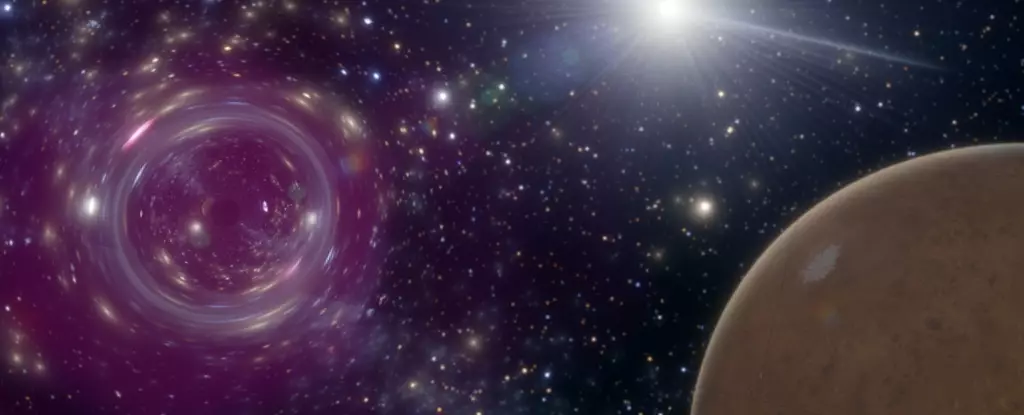The cosmos has long fascinated humanity, igniting curiosity regarding its mysteries and the mechanisms that govern its existence. Among these enigmas, primordial black holes (PBHs) stand out as astonishing, if hypothetical, entities that could reshape our understanding of the universe. Emerging from the conditions shortly after the Big Bang, these ancient black holes could be gliding silently through our Solar System, influencing the celestial bodies around them. Recent research indicates that we might encounter one of these mysterious objects approximately every ten years, a revelation that could significantly advance our comprehension of dark matter.
Primordial black holes, predicted to have formed within the first seconds post-Big Bang, are believed to arise from the gravitational collapse of dense regions of ionized matter. Over billions of years, these entities may have dispersed throughout the universe, leaving behind tantalizing clues about their existence. Some astrophysicists posit that PBHs could serve as a leading candidate for dark matter, the elusive substance making up nearly 27% of the universe’s total mass, yet remaining detectable only through its gravitational influences.
A recent investigation by physicists in the U.S. has shed light on how we may be able to detect these primordial black holes by examining the gravitational effects they exert on nearby celestial bodies. Specifically, researchers have focused on Mars, where the influence of a PBH passing within a distance of about 450 million kilometers (280 million miles) would induce a measurable wobble in the planet’s orbit. The predicted displacement is a mere 1 meter (3.3 feet) over a decade, but given the precision of current distance measurements—typically within 10 centimeters (4 inches)—this slight alteration could be detectable.
The study’s lead author, Tung Tran from the Massachusetts Institute of Technology (MIT), cleverly approached this inquiry with a hypothetical scenario: what would occur if a PBH approached an individual closely? Although such a close encounter is astronomically improbable, the curiosity from this question propelled the research into the quantifiable effects a PBH could exert on planetary bodies. The researchers extrapolated these effects and found that, while gravitational factors causing the wobbling dynamics are complex, Mars provided the clearest signature—largely due to its extensive monitoring through various space missions.
This leads to a significant consideration: Could similar gravitational disturbances be triggered by asteroids passing through the Solar System? While it is true that asteroids interact gravitationally with planets, their effects manifest differently compared to the swift and substantial influence of primordial black holes. Asteroids tend to move more slowly and follow more predictable orbits, potentially diluting their effects and making them detectable only over longer timescales. In contrast, the rapid traversal of a PBH—capable of speeds up to 200 kilometers per second—creates momentary but intense gravitational interactions that can be identified against the backdrop of normal celestial motions.
As researchers delve deeper into this subject, they recognize the complexity of the gravitational dynamics at play. They highlight the need for thorough simulations involving multiple objects and the various factors influencing their movements to create a clearer picture of the gravitational landscape within our Solar System. “To better understand this intricate interplay,” states physicist David Kaiser, “we need to differentiate between the mundane behaviors of asteroids and the more erratic behavior of primordial black holes.”
If astronomers can adequately characterize the expected gravitational effects of primordial black holes, they may be able to harness this knowledge to discover new insights into dark matter. Unraveling this cosmic puzzle may not only illuminate our past but also provide a more nuanced understanding of how these mysterious entities interact with visible matter.
The excitement surrounding this research lies in the eventual possibility of observing a tangible effect—a Martian wobble—indicating the presence of a PBH. With darkness still enveloping much of our understanding of the universe, every piece of evidence carries immense potential for shedding light on complex phenomena. The exploration of these ancient black holes could redefine notions of mass, energy, and the very fabric of our reality.
While primordial black holes remain enigmatic figures in the cosmic theater, their potential influence within our Solar System represents an enriching frontier in astrophysical research. The intersection of theoretical physics and observational astronomy may soon yield remarkable revelations, hinting at an intricately woven tapestry of existence waiting to be understood. As we stand at the brink of discovery, the celestial dance of these ancient entities beckons, challenging our conception of the universe and urging us to dive ever deeper into the mysteries above.

